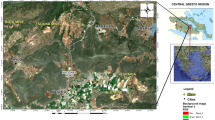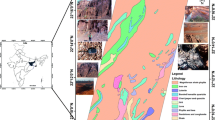Abstract
This study attempts grade-wise mapping in a limestone mine in Ariyalur, Southern India, and in the iron ore mines of Noamundi, Eastern India. After noise removal in the Sentinel 2A (multispectral) and EO-1 Hyperion (hyperspectral) image datasets, spectral matching is performed using the Jeffries-Matusita (JM) distance, Spectral Correlation Mapper (SCM), and combined JM-SCM measure. Due to the specific absorption spectra for carbonates (1900 nm, 2000 nm, and 2160 nm) and iron oxide (865 nm), it is possible to identify and map such mineral deposits using the multispectral dataset (Sentinel 2A) and hyperspectral dataset (EO-1 Hyperion) respectively. The grade-wise mapping of carbonate in the Ariyalur mine using the Sentinel 2A dataset by the Jeffries-Matusita (JM) approach and Spectral Correlation Mapper (SCM) yielded R2 values of 0.44 and 0.77 respectively, whereas the combined JM-SCM approach resulted in a higher correlation with an R2 value of 0.87. The grade-wise mapping of iron oxide in Noamundi using the EO-1 Hyperion dataset by the Jeffries-Matusita (JM) approach and the Spectral Correlation Mapper (SCM) approach yielded R2 values of 0.15 and 0.76, respectively, whereas the combined JM-SCM approach resulted in a higher correlation with an R2 value of 0.90. Such an improved performance of the combined approach is primarily due to the simultaneous and effective utilization of band-wise information (by JM) and correlation aspects (by SCM) of the reference and target spectra considered in the matching algorithm. Thus, in this study, the proposed algorithm proved its compatibility and utility in extracting information on mineral abundance distribution for mine areas.













Similar content being viewed by others
Data availability
The raw image datasets used in this study are available in the United States Geological Survey (USGS) Earth Explorer repository (https://earthexplorer.usgs.gov/).
References
Abrams MJ, Ashley RP, Rowan LC, Goetz AFH, Kahle AB (1977) Mapping of hydrothermal alteration in the Cuprite mining district, Nevada using aircraft scanner images for the spectral region 0.46 to 2.36 μm. Geology 5(12):713–718. https://doi.org/10.1130/0091-7613(1977)5<713:MOHAIT>2.0.CO;2
Bojinski S, Schaepman M, Schlaper D, Itten K (2003) SPECCHIO: a spectrum database for remote sensing applications. Comput Geosci 29:27–38. https://doi.org/10.1016/S0098-3004(02)00107-3
Boori MS, Paringer RA, Choudhary K, Kupriyanov AV (2018) Comparison of hyperspectral and multi-spectral imagery to building a spectral library and landcover classification performance. Comput Opt 42(6):1035–1045. https://doi.org/10.18287/2412-6179-2018-42-6-1035-1045
Chattoraj SL, Prasad G, Sharma RU, van der Meer FD, Guha A, Pour AB (2020) Integration of remote sensing, gravity and geochemical data for exploration of cu-mineralization in Alwar basin, Rajasthan, India. Int J Appl Earth Obs Geoinf 91:102162. https://doi.org/10.1016/j.jag.2020.102162
Clark RN (1999) Spectroscopy of rocks and minerals, and principles of spectroscopy. Manual of Remote Sensing 3(3–58):2–2
Clark RN, Swayze GA, Livo KE, Kokaly RF, Sutley SJ, Dalton JB, McDougal RR, Gent CA (2003) Imaging spectroscopy: earth and planetary remote sensing with the USGS Tetracorder and exper systems. J Geophys Res 108(E12):1–44. https://doi.org/10.1029/2002JE001847
Congalton RG (1991) A review of assessing the accuracy of classifications of remotely sensed data. Remote Sens Environ 37(1):35–46. https://doi.org/10.1016/0034-4257(91)90048-B
De Carvalho OA, Meneses PR (2000) Spectral correlation mapper (SCM): an improvement on the spectral angle mapper (SAM). Ninth JPL airborne earth science workshop. Pasadena, California
Ding JG, Li XB, Huang LQ (2015) A novel method for spectral similarity measure by fusing shape and amplitude features. J Eng Sci Technol Rev 8(5):172–179
Du Y, Chang CI, Ren H, Chang CC, Jensen JO, D'Amico FM (2004) New hyperspectral discrimination measure for spectral characterization. Opt Eng 43(8):1777–1787. https://doi.org/10.1117/1.1766301
Fasnacht L, Vogt ML, Renard P, Brunner P (2019) A 2D hyperspectral library of mineral reflectance, from 900 to 2500 nm. Sci Data 6(1):1–7. https://doi.org/10.6084/m9.figshare.9963167
Flaash UG (2009) Atmospheric correction module: QUAC and FLAASH user guide, 4.7 edn. ITT visual information solutions Inc, Boulder
Galal A, Hasan H, Imam IF (2012) Learnable hyperspectral measures. Egypt Inform J 13(2):85–94. https://doi.org/10.1016/j.eij.2012.04.004
Goetz AFH, Srivastava V (1985) Mineralogical mapping in the Cuprite mining district. Nevada, AIS Data Analysis Workshop, Pasadena, California
Hunt GR, Salisbury JW (1971) Visible and near infrared spectra of minerals and rocks. II. Carbonates. Mod Geol 2:23–30
Jain R, Sharma RU (2019) Airborne hyperspectral data for mineral mapping in Southeastern Rajasthan, India. Int J Earth Obs Geoinformation 81:137–145. https://doi.org/10.1016/j.jag.2019.05.007
Kavzoglu T, Mather PM (2000) The use of feature selection techniques in the context of artificial neural networks. Twenty sixth annual conference of the remote sensing society, Leicester
Khan SD, Jacobson S (2008) Remote sensing and geochemistry for detecting hydrocarbon microseepages. Geol Soc Am Bull 120(1–2):96–105. https://doi.org/10.1130/0016-7606(2008)120[96:RSAGFD]2.0.CO;2
Kruse FA, Lefkoff AB, Boardman JW, Heidebrecht KB, Shapiro AT, Barloon PJ, Goetz AFH (1993) The spectral image processing system (SIPS)- interactive visualization and analysis of imaging spectrometer data. AIP Conf Proc 283(1):192–201
Kumar C, Chatterjee S, Oommen T (2020) Mapping hydrothermal alteration minerals using high-resolution AVIRIS-NG hyperspectral data in the Hutti-Maski gold deposit area, India. Int J Remote Sens 41(2):794–812
Magendran T, Sanjeevi S (2014) Hyperion image analysis and linear spectral unmixing to evaluate the grades of iron ores in parts of Noamundi, Eastern India. Int J Appl Earth Obs Geoinf 26:413–426. https://doi.org/10.1016/j.jag.2013.09.004
Mistrik R, Lutisan J, Huang Y, Suchy M, Wang J, Raab M (2013) mzCloud: a key conceptual shift to understand ‘Who’s who’ in untargeted metabolomics. Metabolomics Society Conference, Glasgow
Muwanguzi AJ, Karasev AV, Byaruhanga JK, Jonsson PG (2012) Characterization of chemical composition and microstructure of natural iron ore from Muko deposits. Int Sch Res Notices 2012:1–9. https://doi.org/10.5402/2012/174803
Naresh Kumar M, Seshasai MVR, Vara Prasad KS, Kamala V, Ramana KV, Dwivedi RS, Roy PS (2011) A new hybrid spectral similarity measure for discrimination among Vigna species. Int J Remote Sens 32(14):4041–4053. https://doi.org/10.1080/01431161.2010.484431
Nidamanuri RR, Zbell B (2011) Normalized spectral similarity score. IEEE J Sel Top Appl Earth Obs Remote Sens 4:226–240. https://doi.org/10.1109/JSTARS.2010.2086435
Padma S, Sanjeevi S (2014) Jeffries Matusita based mixed-measure for improved spectral matching in hyperspectral image analysis. Int J Appl Earth Obs Geoinf 32:138–151. https://doi.org/10.1016/j.jag.2014.04.001
Padma S, Sanjeevi S (2016) Spectral correlation and Jeffries-Matusita based matching algorithm for improved information extraction from hyperspectral images. Thirty seventh Asian conference on remote sensing, Colombo
Panda S, Jain MK, Jeyaseelan AT (2018) A study and implications on the potential of satellite image spectral to assess the iron ore grades of Noamundi iron deposits area. J Geol Soc India 91(2):227–231. https://doi.org/10.1007/s12594-018-0840-y
Rejith RG, Sundararajan M, Gnanappazham L, Loveson VJ (2020) Satellite-based spectral mapping (ASTER and Landsat data) of mineralogical signatures of beach sediments: a precursor insight. Geocarto Int 1–24. https://doi.org/10.1080/10106049.2020.1750061
Ren Z, Sun L, Zhai Q (2020) Improved k-means and spectral matching for hyperspectral mineral mapping. Int J Appl Earth Obs Geoinf 91:102154. https://doi.org/10.1016/j.jag.2020.102154
Sabins FF (1999) Remote sensing for mineral exploration. Ore Geol Rev 14(3–4):157–183. https://doi.org/10.1016/S0169-1368(99)00007-4
Sanjeevi S (2008) Targeting limestone and bauxite deposits in southern India by spectral unmixing of hyperspectral image data. Int Arch Photogramm Remote Sens Spat Inf Sci 37(B8):1189–1194
Shanmugam S, SrinivasaPerumal P (2014) Spectral matching approaches in hyperspectral image processing. Int J Remote Sens 35(24):8217–8251. https://doi.org/10.1080/01431161.2014.980922
Thangavelu M, Shanmugam S, Bhattacharya AK (2011) Hyperspectral radiometry to quantify the grades of iron ores of Noamundi and Joda mines, Eastern India. J Indian Soc Remote Sens 39:473–483. https://doi.org/10.1007/s12524-011-0109-z
Van Der Meer F (2006) The effectiveness of spectral similarity measures for the analysis of hyperspectral imagery. Int J Appl Earth Obs Geoinf 8(1):3–17. https://doi.org/10.1016/j.jag.2005.06.001
Vishnu S, Nidamanuri RR, Bremananth R (2013) Spectral material mapping using hyperspectral imagery: a review of spectral matching and library search methods. Geocarto Int 28(2):171–190. https://doi.org/10.1080/10106049.2012.665498
Williams NR, Holtzhausen S (2001) The impact of ore characterization and blending on metallurgical plant performance. J S Afr I Min Metall 101(8):437–446
Acknowledgments
The authors thank the United States Geological Survey for the Sentinel 2A and EO-1 Hyperion datasets. Further, the authors thank the RAMCO limestone mines, Ariyalur, India, for their support in collection of field data.
Code availability
The algorithms implemented in the study are of custom code type and will be available with the corresponding author.
Author information
Authors and Affiliations
Corresponding author
Ethics declarations
Conflict of interest
All the three authors declare that there is certainly no conflict of interest with regard to this scientific paper titled “Satellite imagery and spectral matching for improved estimation of calcium carbonate and iron oxide abundance in mine areas”
Additional information
Responsible Editor: Biswajeet Pradhan
Rights and permissions
About this article
Cite this article
SrinivasaPerumal, P., Shanmugam, S. & Ganapathi, P. Satellite imagery and spectral matching for improved estimation of calcium carbonate and iron oxide abundance in mine areas. Arab J Geosci 13, 914 (2020). https://doi.org/10.1007/s12517-020-05859-w
Received:
Accepted:
Published:
DOI: https://doi.org/10.1007/s12517-020-05859-w




